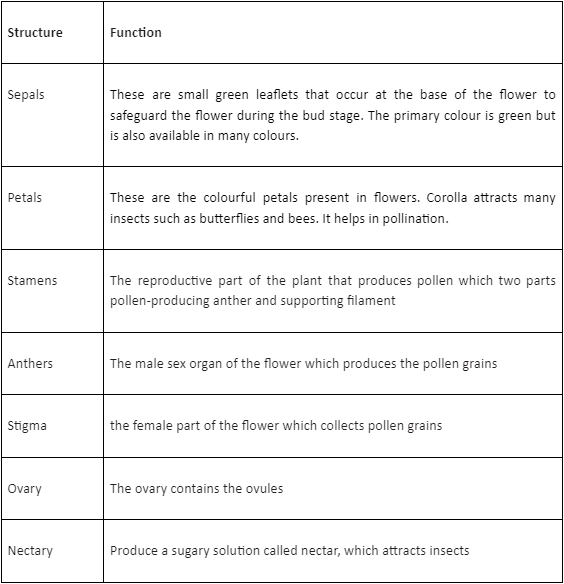Introduction
Megasporangium is part of the female reproductive system in plants. Alternatively, it can be called an ovule. It consists of a nucellus and an integument. The ovule can differ in shape and size after maturation.
Megasporangium in Angiosperms
Megasporangium or the ovule contains megaspores. Megaspores further divide to give rise to the megagametophyte. After this division, remnants are the only things left, and they form the whole of the nucellus. Hence, Nucellus is the megasporangium in an Angiosperm ovule. The nucellus is the inner part of the ovule.
Mature megasporangium can be classified into 5 types.
- Orthotropous or atropous – The micropyle, the chalaza, and the funicle all lie in a plane in such ovaries. They are present in polygonum and cycas plants. They are the most primitive and underdeveloped ovules
- Anatropous – These ovules are present in almost 80% of the angiosperms. The ovule is placed inverted to the funicle
- Campylotropous – The ovary is placed 90 degrees to the funicle but the micropyle is bent downwards in such plants. Plants of the Leguminaceae family have campylotropous ovaries
- Amphitropous – The embryo sac is shaped like a horseshoe in such plants. Poppy and Lemna are the most common examples
- Hemianatropous – The ovule basically turns 90 degrees from the funicle in such plants. Ranunculus is an example of Hemianatropous ovaries
Function of Parts of Flower

The ovary of the flower is divided into numerous other parts, and each part of this flower performs a specific function. Megasporangium proper is the highlighted central area of the flower, which surrounds the female gametophyte and provides nutrition to the flower.
Structure
The ovule, i.e. female reproductive part, is bridged to the placenta by the funicle. Helium is the end of the connection between the placenta and the funicle. Each ovule is covered with a layer called integuments which surrounds the nucellus. At all the tips, the layering of the integument is absent, creating a small opening known as micropyle. Opposite to micropylar, there is chalaza which forms the basal part of the ovule.
The nucellus is considered the main body of the ovule. The embryo sac that contains the female gamete lies inside the nucellus. The diploid megaspore mother cell undergoes meiosis to form 4 haploid megaspores by the process of megasporogenesis. Out of four megaspores, three degenerates, and only one is functional.
The functional megaspore develops into a female gametophyte. It is a 7 celled, 8 nucleated structure consisting of 2 synergids, 3 antipodal cells, 2 polar nuclei and 1 egg cell.
Function
Megasporangium (female reproductive organ) produces megasporocytes, but in some plants like Balanophora, the embryo sac is given rise by micropylar megaspore. In the Onagraceae family, similar conditions prevail. The nucellus is the central part of the ovule. One of the cell present in the megasporangium undergoes meiotic divisions to form the megaspores. Megasporangium
Megasporogenesis
Megasporogenesis is defined as the formation of haploid megaspores from megaspore mother cells. The diploid megaspore mother cell divides meiotically inside the megasporangium to form the megaspores.
The further mitotic division of the megaspore leads to the formation of the embryo sac.
The Megaspore mother cell is diploid in nature with dense cytoplasm and a prominent nucleus. It undergoes meiotic division to form 4 haploid megaspores. Among these, only one megaspore is functionally active, and the rest three haploid cells degenerate.
The nucleus of the functional megaspore then undergoes mitotic divisions. It then forms another 8 haploid cells to form the megagametophyte. It can also be called the embryo sac.
Monosporic development happens when the development of the embryo sac takes place from a single megaspore.
The mitotic division of the nucleus of the active megaspore forms two nuclei which move to opposite poles and develops into the two-nucleate embryo sac.
Two more sequential mitotic divisions result in the formation of the four-nucleate and later the eight nucleate stages of the embryo-sac.
The mitotic divisions are free nuclear which means that nuclear divisions are not followed immediately by cell wall formation.
The cell walls are formed later, which results in the formation of a female gametophyte or embryo sac.
An angiosperm embryo sac is 8-nucleated and 7 celled.
Conclusion
In flowering plants the megasporangium contains the ovules, nucellus, and integuments. A megaspore undergoes sequential meiotic and mitotic division to form the megasporangium and the process is defined as megasporogenesis. The article also focuses on defining megasporangium, its parts, and functions performed by it.
 Profile
Profile Settings
Settings Refer your friends
Refer your friends Sign out
Sign out






